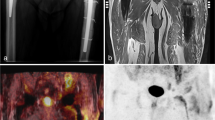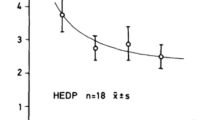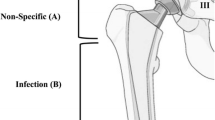Abstract
We compared the accuracy of fluorine-18 labelled 2-fluoro-2-deoxy-d-glucose positron emission tomography (18FDG PET) with that of technetium-99m hexamethylpropylene amine oxime leucocyte scintigraphy (LS) in the detection of infected hip prosthesis. Seventeen patients with a hip prosthesis suspected for infection were prospectively included and underwent 99mTc-methylene diphosphonate bone scintigraphy (BS), LS and an 18FDG-PET scan within a 2-week period. Seven volunteers with ten asymptomatic hip prostheses were used as a control group and underwent BS and an 18FDG-PET scan. Bacteriology of samples obtained by surgery or by needle aspiration and/or clinical follow-up for up to 6 months were used as the gold standard. Planar images of BS and LS (4 and 24 h p.i.) were acquired, followed by single-photon emission tomography (SPET) LS images (after 4 h). These images were scored as positive or negative by two experienced readers. The 18FDG-PET scans of the patients were compared with the tracer distribution pattern in the asymptomatic control group and with BS. A phantom study was performed in order to identify artefacts. For this purpose, three different attenuation correction methods were tested. The combined analysis of the planar BS and LS resulted in a 75% sensitivity and a 78% specificity. The SPET LS images showed a better lesion contrast, resulting in an 88% sensitivity and a 100% specificity, while 24-h planar images were of no additional value. The analysis of PET images alone resulted in an 88% sensitivity and a 78% specificity. The combination of 18FDG-PET and BS images resulted in an 88% sensitivity and a 67% specificity. Given the presence of small errors near the edge of the metal, which can induce significant artefacts in the corrected emission image, we decided to use the data without attenuation correction. In this preliminary study, 18FDG-PET scans alone showed the same sensitivity as combined BS and LS, although the specificity was slightly lower.




Similar content being viewed by others
References
Oyen WJG, Lemmens JAM, Claessens RAMJ, Van Horn JR, Slooff TJJH, Corstens FHM. Nuclear arthrography: combined scintigraphic and radiographic procedure for diagnosis of total hip prosthesis loosening. J Nucl Med 1996; 37:62–70.
Maderazo EG, Judson S, Pasternak H. Late infections of total joint prosthesis. A review and recommendations for prevention. Clin Orthop 1988; 229:131–141.
Spangehl MJ, Younger ASE, Marsi BA, Duncan CP. Diagnosis of infection following total hip arthroplasty. J Bone Joint Surg 1997; 79-A:1578–1586.
Zhuang H, Duarte PS, Pourdehnad M, Maes A, Van Acker F, Shnier D, Garino JP, Fitzgerald RH, Alavi A. The promising role of18F-FDG PET in detecting infected lower limb prosthesis implants. J Nucl Med 2001; 42:44–47.
Chik KK, Magee MA, Bruce WJ, Higgs RJ, Thomas MG, Allman KC, Van Der Wall H. Tc-99m stannous colloid-labeled leucocyte scintigraphy in the evaluation of the painful arthroplasty. Clin Nucl Med 1996; 21:838–843.
Levitsky KA, Hozack WJ, Balderston RA, et al. Evaluation of the painful prosthetic joint: relative value of bone scan, sedimentation rate, and joint aspiration. J Arthroplasty 1991; 6:237–244.
Larikka MJ, Ahonen AK, Junila JA, Niemelä O, Hämäläinen MM, Syrjälä HP. Extended combined99mTc-white blood cell and bone imaging improves the diagnostic accuracy in the detection of hip replacement infections. Eur J Nucl Med 2001; 28:288–293.
Piert M, Winter E, Becker GA, Bilger K, Machumma HJ, Müller-Schauenburg W, Bares R, Becker HD. Allogenic bone graft viability after hip revision arthroplasty assessed by dynamic18F fluoride ion positron emission tomography. Eur J Nucl Med 1999; 26:615–624.
Fehring TH, Cohen B. Aspiration as a guide to sepsis in revision total hip arthroplasty. J Arthroplasty 1996; 11:543–547.
Itasaka T, Kawai A, Sato T, Mitani S, Inoue H. Diagnosis of infection after total hip arthroplasty. J Orthop Sci 2001; 6:320–326.
Fitzgerald RHJ. Diagnosis and management of the infected hip prosthesis. Orthopedics 1995; 18:833–835.
Rennen HJJM, Boerman OC, Oyen WJG, Corstens FHM. Imaging infection/inflammation in the new millennium. Eur J Nucl Med 2000; 28:241–249.
Stumpe KDM, Dazz H, Schaffner A, von Schulthess GK. Infection imaging using whole-body FDG-PET. Eur J Nucl Med 2000; 27:822–832.
Scher DM, Pak K, Lonner JH, Finkel JE, Zuckerman JD, Cesare PED. The predictive value of indium-111 leucocyte scans in the diagnosis of infected total hip, knee, or resection arthroplasties. J Arthroplasty 2000; 15:295–300.
Kraemer WJ, Saplys R, Waddell JP, Morton J. Bone scan, gallium scan and hip aspiration in the diagnosis of infected total hip arthroplasty. J Arthroplasty 1993; 8:611–615.
King AD, Peters AM, Stuttle AWJ, Lavender JP. Imaging of bone infection with labelled white blood cells: role of contemporaneous bone marrow imaging. Eur J Nucl Med 1990; 17:148–151.
Zhuang H, Alavi A. 18-fluorodeoxyglucose positron emission tomographic imaging in the detection and monitoring of infection and inflammation. Semin Nucl Med 2002; 32:47–59.
Zhuang H, Chacko TK, Hickeson M, Stevenson K, Feng Q, Ponzo F, Garino JP, Alavi A. Persistent non-specific FDG-uptake on PET imaging following hip arthroplasty. Eur J Nucl Med Mol Imaging 2002; 29:1328–1333.
Yamada S, Kubota K, Kubota R, Ido T, Tamahashi N. High accumulation of fluorine-18-fluorodeoxyglucose in turpentine-induced inflammatory tissue. J Nucl Med 1995; 36:1301–1305.
Nuyts J, Dupont P, Stroobants S, Maes A, Mortelmans L, Suetens P. Evaluation of maximum-likelihood based attenuation correction in positron emission tomography. IEEE Trans Nucl Sci 1999; 46:1136–1141.
Hudson HM, Larkin RS. Accelerated image reconstruction using ordered subsets of projection data. IEEE Trans Med Imaging 1994; 13:601–609.
Nuyts J, Stroobants S, Dupont P, Vleugels S, Flamen P, Mortelmans L. A dedicated ML-algorithm for non-attenuation corrected PET whole body images. Proc IEEE NSS MIC, October 15–20, 2000, Lyon, France.
Hudson HM, Larkin RS. Accelerated image reconstruction using ordered subsets of projection data. IEEE Trans Med imaging 1994; 13:601–609.
Mortelmans L, Malbrain S, Stuyck J. In vivo and in vitro evaluation of granulocyte labelling with (Tc-99m)d,l-HM-PAO. J Nucl Med 1989; 30:2022–2028.
Van Acker F, Nuyts J, Maes A, Vanquickenborne B, Stuyck J, Bellemans J, Vleugels S, Bormans G, Mortelmans L. Evaluation of painful total knee arthroplasties: FDG PET versus Tc-99m HMPAO white blood cell SPECT. Eur J Nucl Med 2001; 10:1496–1504.
Fehring TK, Cohen B. Aspiration as a guide to sepsis in revision total hip arthroplasty. J Arthroplasty 1996; 11:543–547.
Sciuk J, Puskas C, Greitemann, Schober O. White blood cell scintigraphy with monoclonal antibodies in the study of infected endoprosthesis. Eur J Nucl Med 1992; 19:497–502
Tigges S, Stiles RG, Meli RJ, Roberson JR. Hip aspiration: a cost-effective and accurate method of evaluating the potentially infected hip prosthesis. Radiology 1993; 189:485–488.
Vorne M, Soini I, Lantto T, Paakkinen S. Technetium-99m HMPAO-labeled leucocytes in detection of inflammatory lesions: comparison with gallium-67 citrate. J Nucl Med 1989; 30:1332–1336.
Becker W, Goldenberg DM, Wolf F. The use of monoclonal antibodies and antibody fragments in the imaging of infectious lesions. Semin Nucl Med 1994; 24:142–153.
Dams ETM, Oyen WJG, Boerman OC, Storm G, Laverman P, Kok PJM, Buijs WCAM, Bakker H, van der Meer JWM, Corstens FHM.99mTc-PEG liposomes for the scintigraphic detection of infection and inflammation: clinical evaluation. J Nucl Med 2000; 41:622–630.
Yapar Z, Kibar M, Yapar AF, Togrul E, Kayaselçuk U, Sarpel Y. The efficacy of technetium-99m ciprofloxacin (Infecton) imaging in suspected orthopaedic infection: a comparison with sequential bone/gallium imaging. Eur J Nucl Med 2001; 28:823–830.
Sugawara Y, Braun DK, Kison PV, Russo JE, Zasadny KR, Wahl RL. Rapid detection of human infections with fluorine-18-fluorodeoxyglucose and positron emission tomography: preliminary results. Eur J Nucl Med 1998; 25:1238–1243.
Hawkins RA, Hoh C, Glaspy J, Choy Y, Phelps ME. Positron emission tomography scanning in cancer. Cancer Invest 1994; 12:74–78.
Zhuang HM, Duarte P, Shnier D, Alavi A. Exclusion of chronic osteomyelitis with FDG-PET. J Nucl Med 1999; 40 Suppl:15P–16P.
Shnier D, Benard F, Glaser D, Garino J, Alavi A. FDG-PET imaging accurately assesses suspected infection of orthopedic prostheses. J Nucl Med 1998; 39 Suppl:33P.
Zhuang HM, Duarte P, Shnier D, Alavi A. FDG-PET imaging is more accurate in detecting infection associated with hip prosthesis than that associated with knee prosthesis. J Nucl Med 1999; 40 Suppl:193P–194P.
Rennen HJJB, Boerman OC, Oyen WJG, van der Meer JWM, Corstens FHM. Specific and rapid scintigraphic detection of infection with99mTc-labeled interleukin-8. J Nucl Med 2001; 42:117–123.
Dams ET, Oyen WJ, Boerman OC, et al.99mTc-PEG liposomes for the scintigraphic detection of infection and inflammation: clinical evaluation. J Nucl Med 2000; 41:622–630.
Author information
Authors and Affiliations
Corresponding author
Rights and permissions
About this article
Cite this article
Vanquickenborne, B., Maes, A., Nuyts, J. et al. The value of 18FDG-PET for the detection of infected hip prosthesis. Eur J Nucl Med Mol Imaging 30, 705–715 (2003). https://doi.org/10.1007/s00259-002-1109-6
Received:
Accepted:
Published:
Issue Date:
DOI: https://doi.org/10.1007/s00259-002-1109-6




